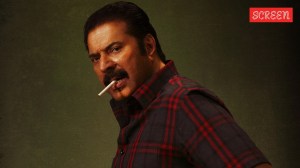Sujata Bajaj’s Spacescapes: An immersive journey into the cosmos
The Paris-based artist speaks about the fascinating and complex relationship between science and art
 Artist Sujata Bajaj at her exhibition 'Spacescapes' at Gallery Art & Soul in Mumbai. (Express Photo)
Artist Sujata Bajaj at her exhibition 'Spacescapes' at Gallery Art & Soul in Mumbai. (Express Photo) Inspired by the cosmos and its varied elements, artist Sujata Bajaj’s recent exhibition titled ‘Spacescapes’ at Gallery Art & Soul in Mumbai featured large-scale canvases in dramatic orchestrations of colour, flowing organically without structured patterns. In an email interview, the Paris-based artist talks about gazing at the skies as a child, referencing astronomical research and changing her technique for the series.
Could you talk about taking inspiration from the James Webb Space Telescope images and interpreting the cosmos?
The images struck me as a representation of infinite freedom and immeasurable depth. This is what sparked my initial fascination with the topic. As I leaned into the research, I quickly realised this subject lent itself perfectly to a desire I have harboured since long — a wish to reach a state where I feel zero constraint with my brush, and you’ll notice the difference from past works to ‘Spacescapes’. Here, it is all about absolute fluidity, resulting in colours and strokes that are not controlled by any shape or movement.
 Acrylic on canvas with silver leaf. (Express Photo)
Acrylic on canvas with silver leaf. (Express Photo)
What is your memory of growing up in Jaipur, gazing at the stars as a child? What did the cosmos represent for you then?
I have always had a love for sleeping outside and gazing at the stars. It is an experience I have had on several trips to Africa, where the stars are simply unmatched by anything else. There is a peace in gazing at the grandeur of it all and the humility of realising that we are such a small part of a much bigger engine. It feels empowering as well to know how vast the world is. To me, as a child, it represented a sense of adventure and limitless opportunity, a lack of boundaries and the possibility to venture into alternate realities, further fuelling my creativity.
In the book accompanying the exhibition, you mention how ‘Spacescapes’ required a different technique to paint, a slight departure from your usual practice.
The focus of these works is freedom and movement. To translate this, I had to develop a new relationship to both my colours and my brushes. It was not about creating thick layers and bold strokes, concise shapes and sharp lines cutting through them. Here, it was about letting colours find one another and almost developing their dynamics on the canvas. I created a platform for my colours to interact in a new way, giving them very little direction and full agency to dance with one another as they please — the only requirement was that they had to fit into my understanding of the overarching cosmic theme.
The colours, hence, had to be far more liquid in consistency to allow for such play. The use of metallic leaves, both silver and gold, creates additional depth while alluding to both singular stars and clusters.
The works in the exhibition also reference astronomical facts, including constellations, stars. If you could tell us about the research process.
It began with imagery from the Hubble telescope as well as the James Webb telescope. The research was primarily visual, as I am a visual person first and foremost. I also enjoyed learning more about astronomy in the process. The concept of Nebulae, especially. My husband is an academic and he took great joy in diving into the topic from a more rational and scientific angle, regularly sharing with me snippets of his findings when he felt they could inform the work or add context for me.
Science and art share a complex and fascinating relationship. What prompted you to delve into it through your work? Were there any past works of art that you also referenced during your research or artists who acted as inspiration?
Interestingly enough, often art is seen as a matter of total subjectivity and science as one of absolute objectivity, and that makes it almost wonderful to think that there are ways they can be coming together. Leading astrophysicist David Elbaz has also written a beautiful essay in my book.
That being said, there was no longstanding intent for me to create a bridge between both spaces on purpose. It just happened. It occurred because I was visually inclined toward the images I saw representing space, but mostly I was energetically drawn to a feeling. I felt like a match for something I had been trying to express for a very long time. There is an energy in my being that art has always allowed me to express, but I was yearning for an additional form, or rather lack of form — a complete explosion, if you will,l of all I have tried to cement for decades. Though, of course, it is very much still my work and I believe it carries my signature, but it is a new dialect of the language I have been trying to perfect for 40 years.







